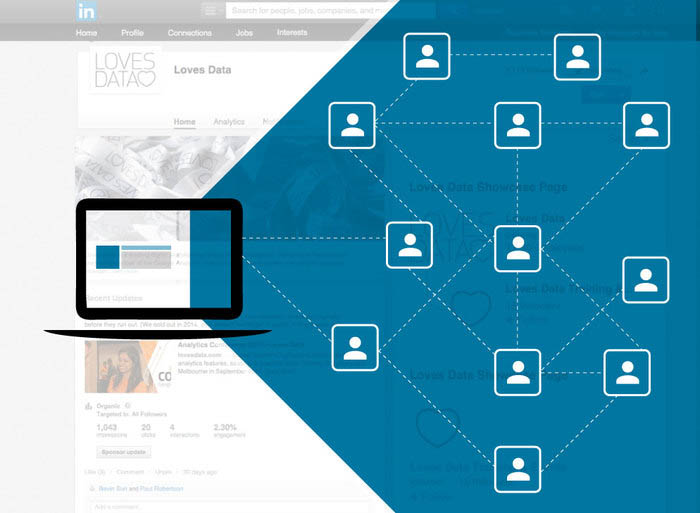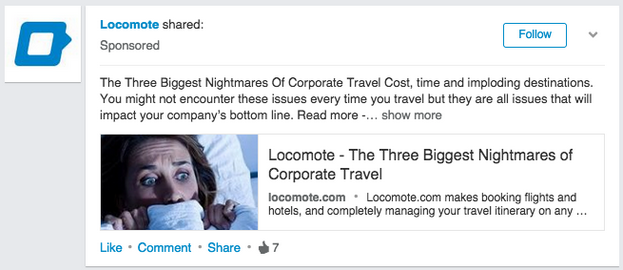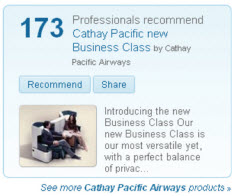What are You Missing Out on with LinkedIn Advertising?
Loves Data

LinkedIn is a social platform that differs from others as it strongly facilitates business relationships through a hub of like-minded professionals. In 2014, LinkedIn hit a major milestone, announcing that they’ve reached 300 million registered users. With a large and rapidly increasing user base, LinkedIn is an important addition to any brand’s social media strategy. Once you’ve established your LinkedIn channel, you may begin thinking about how to invest in and grow your business using LinkedIn – one way to do this is through LinkedIn Advertising.
Just like other social media platforms, you can narrow down your potential audience by targeting your ads based on job title, job function, industry, geography, age, gender, company name, company size or LinkedIn Group.
It’s important to know that your ad could be shown on any or all of the following pages: profile pages, home page, inbox, search results, group pages.
With LinkedIn Advertising, you can choose between text and image ads, video ads and text only ads. Basic ad elements are made up of the following specifications:
- Headline [Max 25 characters]
- Description [Max 75 characters]
- Image: Square image [50x50 pixel]
- URL [sends the user to the ad landing page]
![URL [sends the user to the ad landing page]](https://www.lovesdata.com/media/posts/172/IMAGE-2-Ads-in-a-line.png)
![URL [sends the user to the ad landing page]](https://www.lovesdata.com/media/posts/172/Image-1-Ads-3-in-a-row-1.png)
Other Ad Formats
Textlinks are text-only ads and most LinkedIn users will recognise them as they often feature at the top of the home page as soon as you log in. They are made up of a headline (25 characters) and description (75 characters). They can also be shown on profile pages, company pages, group pages and message pages.

Sponsored updates are posts that appear in a user’s news stream as they scroll through their home page. You can only create sponsored updates by promoting a status that you have already published.

Premium display advertising are all image-based ads. They are available in a number of shapes and dimensions:
- Medium Rectangle ads (300 x 250 pixels) can feature on home pages, profile pages, company pages, group pages and LinkedIn Today
- Wide Skyscraper ads (160 x 600 pixels) are tall ads that appear only on a user’s inbox and message pages
- Leaderboard (728 x 90 pixels) are displayed at the very bottom of a page
Sponsored InMail allows advertisers to send messages to a user’s inbox. These messages tend to be lengthier and include elements such as a message subject line, from (your name or company), text body, links, a call-to-action button and a clickable image on the right hand side. Users are notified of the message with a red notification over the inbox icon and they can click on to read the contents of the message. To avoid spammy tactics, LinkedIn enforces a limit of one ad to be shown per 60 days for their users.

Follow company ads appear on a user’s page with a call-to-action button that allows a user to follow your company page. This is the best form of LinkedIn advertising to use if your objective is to increase your follower base.
Recommendation ads show the company name, the product and the amount of people who have recommended the product and buttons to encourage users to recommend or share the product.

Costs
Now that you know the types of ads, you’ll want to consider the costs. LinkedIn allows you to create a budget between $10.00 – $1,000 per day, with minimum bidding starting at $2.00 for keywords. You can choose between a cost-per-click (CPC) or per 1,000 impressions (CPM) model. Most advertisers will choose CPC for a fairer pricing model plus you’ll receive free impressions.
Based on community averages, you should expect a CPC of around $2 – $5. These are influenced by your competitors (the more competition, the higher you’ll have to bid) and clickthrough rates (which is why your ad elements need to attract attention).
Measure
As with any form of advertising, it’s important to keep track of your budgets, conversions and return on investment (ROI). LinkedIn provides an overview page with basic ad performance data such as number of clicks your ads received, impressions generated, CTR and total spend.
To really make the most of your campaigns and ensure you’re getting the right outcomes, use Google Analytics to analyse your conversion data. Our Director of Digital and Analytics, Benjamin Mangold, has a brilliant post on cost data upload with Google Analytics that uses LinkedIn advertising as an example. Screenshots and a video tutorial are also included (too easy)! You can also compare other social media advertising performance to see which platform takes advertising your dollar further.
https://youtu.be/I_YecD6yKqA
If you’re just starting out with LinkedIn advertising, begin with basic ad formats such as image and text ads or even promote your posts to experiment with ads. Keep in mind your product or service, and whether or not the LinkedIn audience will find value in what you have to offer.
Additional resources
- LinkedIn advertising FAQs
- Banner advertising specs
- LinkedIn advertising guidelines
- LinkedIn’s best practices for ads
We’d definitely like to see better ad performance data from within the LinkedIn interface. What would you like to see LinkedIn improve?
